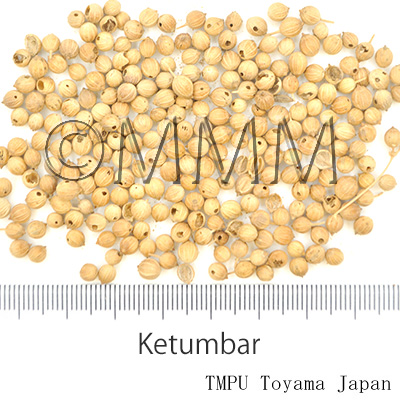Crude drug sample data base
※Click on the image to enlarge it.
Scientific information data base
| Crude drug name | Indonesian name, English name | Ketumbar, Coriander | ||||
|---|---|---|---|---|---|---|
| crude drug image |
| |||||
| Original plant name | Coriandrum sativum Linn. | |||||
| Family name | Umbelliferae | |||||
| Used part | Fruits | |||||
| Distribution area | In South-East Asian countries it is grown as a culinary herb and vegetable. It occurs in mountainous regions in Indonesia, cultivated in unirrigated agricultural field [201]. | |||||
| Description | Fruits are ovoid to globose schizocarp, up to 5 mm in diameter, yellow-brown with straight longitudinal ribs alternating with 10 wavy longitudinal ridges, often crowned by the dry persistent calyx lobes and the stylopodium with styles. The fruit does not split at maturity; it has 2 mericarps and each has vittae that contains essential oil. Each mericarp has one seed with testa attached to the fruit wall. The plant is an erect herb upt o 1.30 m tall. Stem solid, mostly with a white bloom, light green with darker green ribs, sometimes with some violet. Leaves alternate, blade white waxy, shiny green often with darker green veins, ovate or elliptical, usually pinnately divided into 3-11 leaflets. Inflorescence an indeterminate, compound umbel. Fruit an ovoid to globose schizocarp [204]. | |||||
| Drug effect | Pungent, warming [231]. | |||||
| Specific actions | Stomachic. | |||||
| Frequency in use | Abundant. | |||||
| Common uses | It is commonly used as a spice in a large number of Indonesian dishes in home kitchen, mostly in combination with Cuminum cyminum and popularly known as ''ketumbar jinten'' (ketumbar: coriander, jinten: C. cyminum). Leaves also contain essential oil and they are used in the cuisine sometimes. The leaves have a very different taste from the seeds, similar to parsley but ''juicier'' and with citrus-like overtones [201, 204]. | |||||
| Pharmacological effect | Two alpha, beta-unsaturated aldehydes isolated from Coriandrum sativum showed bactericidal activity against S. choleraesuis and this activity comes in part from the ability to act as noninonic surfactants [PMID:15161192]. The antimutagenic activity of coriander juice against the mutagenic activity of 4-nitro-o-phenylenediamine, m-phenylenediamine and 2-aminofluorene was investigated using the Ames reversion mutagenicity assay (his- to his+) with the S. typhimurium TA98 strain as indicator organism. The negative correlation between chlorophyll content and mutagenic response of the promutagenic and direct-acting used amines allows us to deduce that a chemical interaction takes place between the two molecules, leading to the inactivation of mutagenic moiety [PMID:15451560]. Aqueous extract of CCoriandrum sativum seeds has anxyolitic effect and may have potential sedative and muscle relaxant effects [PMID:15619553]. A significant antibacterial activity, as determined with the agar diffusion method, was shown by Coriandrum sativum essential oil. The significant antibacterial activity of essential oils to the bacterial pathogens of mushrooms appears promising [PMID:15612768]. | |||||
| Medical system | Indonesian medicine (Jamu) | |||||
| Traditional usage | It is traditionally applied to treat indigestion and in eliminating discomfort feeling of the body [201]. | |||||
| Formulation | 1) Stomach cramp during menses: 7 pieces of coriander fruits, turmeric (size of an adult finger), 1 piece of Eugenia caryophyllata, a little amount of nutmeg. They are boiled with 110 ml of water to make 100 ml of decoction. Drink the decoction once a day for 3 days [231]. 2) Stomachache: Turmeric (size of an adult finger), 7 pieces of coriander fruits, 7 pieces of Melaleuca leucadendra fruits, 1 teaspoon of powdered Usnea (Usnea sp.) thallus, 3 pieces of Litsea odorifera leaves. All ingredients are mixed and boiled with 110 ml of water to obtain 100 ml of decoction. Drink the decoction once a day for 4 days [231]. | |||||
| References | Reference book Tips! | [201] K. Heyne, Tumbuhan Berguna Indonesia, Vols. 1-4, 1987. Diedarkan Oleh Koperasi Karyawan Departemen Kehutanan, Jakarta, Indonesia. Vol. 3, pp 1546-1547. [204] de Guzman, C.C. and Siemonsma, J.S. (Editors), 1999. Plant Resources of South-East Asia No. 13 Species. Backhuys Publishers, Leiden, Netherlands. p 104. [231] Soedibyo, Mooryati: Alam Sumber Kesehatan: Manfaat dan Kegunaan (Natural resources for health. Benefits and uses). Balai Pustaka. 1998. pp 219-220. | ||||
| Research paper | 1. Emamghoreishi M, Khasaki M, Aazam MF. Coriandrum sativum: evaluation of its anxiolytic effect in the elevated plus-maze. J. Ethnopharmacol., 15;96(3):365-70, 2005. (PMID: 15619553) 2. Lo Cantore P, Iacobellis NS, De Marco A, Capasso F, Senatore F. Antibacterial activity of Coriandrum sativum L. and Foeniculum vulgare Miller var. vulgare (Miller) essential oils. J. Agric. Food Chem., 29;52(26):7862-6, 2004. (PMID: 15612768) 3. Cortes-Eslava J, Gomez-Arroyo S, Villalobos-Pietrini R, Espinosa-Aguirre JJ. Antimutagenicity of coriander (Coriandrum sativum) juice on the mutagenesis produced by plant metabolites of aromatic amines. Toxico.l Lett., 2;153(2):283-92, 2004. (PMID: 15451560) 4. Kubo I, Fujita K, Kubo A, Nihei K, Ogura T. Antibacterial activity of coriander volatile compounds against Salmonella choleraesuis. J. Agric. Food Chem., 2;52(11):3329-32, 2004. (PMID: 15161192) | |||||
| Remarks | [DNA sequence] EU515298 | |||||
| Last renewal date | 2024/03/08 | |||||





